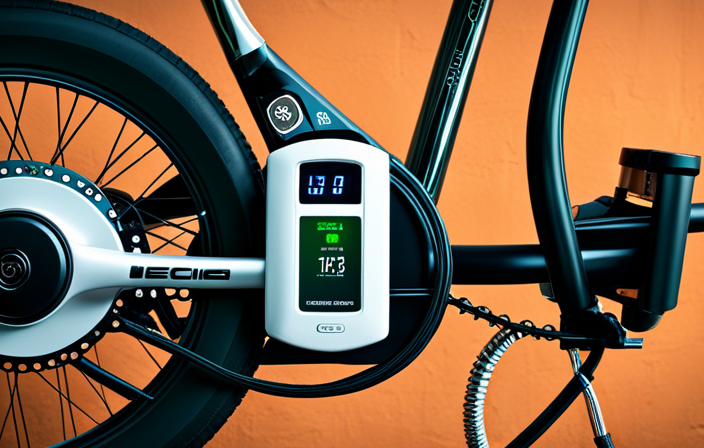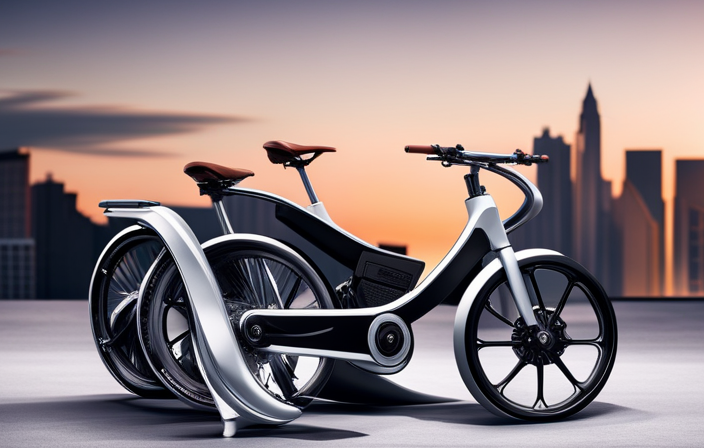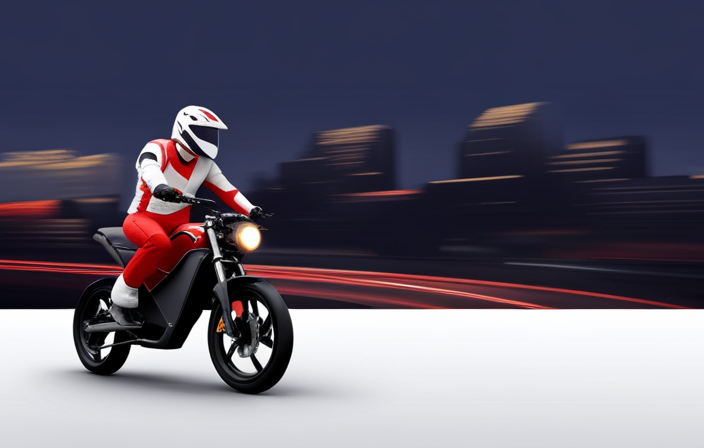Are you tired of the high costs and inconveniences of traditional transportation? Well, get ready to saddle up on an electric bike and ride into a world of savings!
In this article, we’ll take a satirical look at the true cost of running an electric bike. From the initial investment to maintenance, charging expenses, and even insurance and registration, we’ll analyze the data and provide a comprehensive breakdown of the financial aspects.
So fasten your helmet and prepare to be enlightened about the economical wonders of electric biking!
Key Takeaways
- Electric bikes cost $1,000 to $5,000 on average.
- Long-term costs include maintenance and battery replacement.
- Charging time for electric bikes is around 4 to 6 hours.
- E-bike commuters can save up to €1,500 per year compared to car commuters.
Initial Investment
You’ll need to make an initial investment to get started with an electric bike. The cost of an electric bike can vary greatly depending on the brand, model, and features. On average, you can expect to pay anywhere from $1,000 to $5,000 for a quality electric bike.
This initial investment covers the cost of the bike itself, as well as any additional accessories you may want, such as a helmet or lock. It’s also important to consider the long-term costs associated with owning an electric bike. These include regular maintenance, such as tire replacements and brake adjustments, as well as battery replacement, which typically needs to be done every few years.
Transitioning into the next section about maintenance costs, it’s important to factor these expenses into your overall budget for running an electric bike.
Maintenance Costs
To keep up an electric bike, you’ll need to consider the expenses for maintenance. The cost of repairs and the frequency of maintenance play a significant role in determining the overall cost of running an electric bike. Regular maintenance is essential to ensure the bike’s longevity and optimal performance. This includes tasks such as checking and lubricating the chain, inspecting the brakes, and adjusting the gears. Additionally, you may need to replace worn-out tires and brake pads periodically. To give you a better idea of the potential costs, here is a breakdown of common maintenance tasks and their estimated frequency:
| Maintenance Task | Frequency | Cost |
|---|---|---|
| Chain lubrication | Every 200-300 miles | $5-$10 |
| Brake adjustment | Every 500-1000 miles | $10-$20 |
| Tire replacement | Every 1000-2000 miles | $40-$80 |
| Brake pad replacement | Every 1000-2000 miles | $20-$40 |
Considering these maintenance costs is important when evaluating the overall expenses of running an electric bike. Now, let’s move on to the next section and discuss the charging expenses.
Charging Expenses
Make sure you consider the expenses for charging your electric bike. One important factor to consider is the charging time. On average, it takes about 4 to 6 hours to fully charge an electric bike, depending on the battery capacity and charger type. This means that you will need to plan your charging schedule accordingly. Additionally, the electric bike battery charge duration can impact your daily routine, especially if you rely on your bike for commuting. To avoid running out of power unexpectedly, it’s a good idea to charge your bike overnight or during periods of low usage. Being mindful of the electric bike battery charge duration will help ensure a smooth and hassle-free riding experience.
Another important consideration is the cost of electricity rates. The cost of charging your electric bike will depend on the electricity rates in your area. It’s recommended to check with your local utility provider to determine the exact rates. However, on average, it can cost around $0.10 to $0.20 per kilowatt-hour to charge an electric bike.
Considering these factors, it is essential to factor in the expenses for charging your electric bike into your overall budget.
When it comes to insurance and registration, there are additional costs to consider.
Insurance and Registration
Insurance and registration for an electric bike can add to the overall expenses. It is important to understand the insurance coverage and legal requirements for operating an electric bike in your area. Here are three key points to consider:
-
Insurance coverage: Depending on your location and the value of your electric bike, you may need to purchase insurance to protect yourself in case of accidents, theft, or damage. It’s advisable to compare different insurance providers and policies to find the one that best suits your needs and budget.
-
Legal requirements: Some jurisdictions require electric bike owners to register their bikes and obtain a license plate or sticker. Additionally, you may need to carry proof of insurance while riding. Familiarize yourself with the specific laws and regulations in your area to ensure compliance.
-
Cost variations: The cost of insurance and registration can vary depending on factors such as your location, bike value, and insurance provider. It’s recommended to obtain quotes from multiple insurers to compare prices and coverage options.
Considering the expenses related to insurance and registration, it is crucial to factor these costs into your overall budget for running an electric bike.
Moving on to the next section about accessories and upgrades…
Accessories and Upgrades
Upgrading and adding accessories to your electric bike can enhance your riding experience and personalize your bike to fit your needs and style. There are various upgrades and customization options available that can significantly improve your bike’s performance, comfort, and convenience.
Some popular upgrades include installing a more powerful motor, upgrading the battery for longer range, adding suspension forks for a smoother ride, and installing a more advanced display with additional features. Additionally, you can customize your bike with accessories such as fenders, racks, lights, and locks to make it more functional and practical.
These upgrades and accessories can vary in cost depending on the brand and quality, ranging from a few hundred dollars to over a thousand dollars. Investing in these upgrades and accessories can greatly enhance your electric bike riding experience, making it worth considering.
Speaking of value, the next section will discuss the depreciation and resale value of electric bikes.
Depreciation and Resale Value
One factor to consider when purchasing an e-bike is its depreciation and potential resale value. Conducting a depreciation analysis can provide insight into how much value an electric bike loses over time. Based on current resale market trends, here are three key factors to consider:
-
Brand reputation: E-bikes from reputable brands tend to hold their value better in the resale market. Brands with a strong reputation for quality and reliability are more likely to retain their value.
-
Mileage: Higher mileage can significantly impact an e-bike’s resale value. Regular maintenance and proper care can help minimize wear and tear, preserving the bike’s value.
-
Technological advancements: With the continuous evolution of e-bike technology, older models may lose value more quickly. Buyers often prefer newer models with the latest features and improvements.
Considering these factors can help potential buyers estimate the potential depreciation and resale value of an e-bike.
Moving on to the next section about commuting and transportation savings, it is important to analyze the long-term financial benefits of owning an electric bike.
Commuting and Transportation Savings
Commuting with an e-bike can lead to significant savings on transportation expenses. Not only does it eliminate the need for costly gasoline, but it also reduces the wear and tear on a car, extending its lifespan and reducing maintenance costs.
Additionally, e-bikes offer a more cost-effective alternative to public transportation or owning a second car. According to a study by the European Cyclists’ Federation, e-bike commuters can save up to €1,500 per year compared to car commuters.
Furthermore, e-bikes provide a faster and more efficient mode of transportation, reducing commuting time and allowing for a more productive day.
Transitioning into the next section about environmental impact, it’s important to note that e-bikes also have a positive effect on the environment by reducing carbon emissions and promoting sustainable transportation options.
Environmental Impact
Using an e-bike instead of a car for transportation significantly reduces carbon emissions and promotes sustainable transportation options. E-bikes have a much smaller carbon footprint compared to cars, as they produce zero tailpipe emissions. Additionally, e-bikes can be charged using renewable energy sources such as solar or wind power, further reducing their environmental impact.
According to a study by the European Cyclists’ Federation, e-bikes emit only 22 grams of CO2 per kilometer traveled, while cars emit an average of 271 grams. This data-driven analysis clearly demonstrates the environmental benefits of choosing an e-bike over a car.
Transitioning into the subsequent section about health and fitness benefits, it is important to consider that e-biking not only benefits the environment but also has positive impacts on personal well-being.
Health and Fitness Benefits
Get ready to experience improved health and fitness by hopping on an e-bike for your daily transportation needs. Electric bikes offer numerous health benefits and fitness advantages that can positively impact your overall well-being.
Cycling is a low-impact exercise that can help strengthen your cardiovascular system, improve lung function, and boost endurance. By using an electric bike, you can tailor the level of assistance to your fitness level, making it easier to gradually increase your stamina over time.
Additionally, riding an e-bike can help you burn calories, build muscle tone, and improve mental health by reducing stress and anxiety. Incorporating e-bike rides into your daily routine can have long-lasting health benefits.
As we transition into the subsequent section about cost-saving tips, let’s explore how owning an electric bike can also save you money.
Cost-Saving Tips
When it comes to running an electric bike, there are several cost-saving measures you can take. By implementing energy efficient options, you can minimize your expenses while still enjoying the benefits of an electric bike. One way to save on costs is by investing in a bike with regenerative braking, which converts kinetic energy into electrical energy to recharge the battery. Additionally, you can opt for a bike with a removable battery, allowing you to charge it separately and potentially take advantage of off-peak electricity rates. Another cost-saving measure is to use pedal assist mode whenever possible, reducing the reliance on the motor and conserving battery power. By incorporating these strategies, you can make your electric bike usage more economical and sustainable. Moving forward, let’s explore the long-term financial considerations of owning an electric bike.
Long-Term Financial Considerations
Investing in an electric bike can have long-term financial benefits. When considering the cost analysis, it is important to take into account the initial price of the bike, as well as any additional accessories or maintenance costs. However, the long-term savings can outweigh these expenses. Here are three key points to consider:
-
Fuel savings: With an electric bike, there is no need to purchase gasoline, which can save a significant amount of money over time.
-
Maintenance costs: Electric bikes generally have fewer moving parts compared to traditional bikes, resulting in lower maintenance and repair costs.
-
Health benefits: By using an electric bike instead of a car or public transportation, you can save on medical expenses associated with a sedentary lifestyle.
Considering these factors, an electric bike proves to be a worthwhile long-term investment.
Moving forward into the section on personal finance assessment, it is important to evaluate the overall financial impact of owning an electric bike.
Personal Finance Assessment
In evaluating my budget and financial goals, I need to consider the affordability of an electric bike.
I will assess my current financial situation and determine if purchasing an electric bike aligns with my long-term savings and benefits.
By taking into account the cost of purchasing and maintaining an electric bike, I can make an informed decision that supports my financial objectives.
Evaluating your budget and financial goals
To determine how much it’ll cost to run an electric bike, you should first evaluate your budget and financial goals.
Evaluating your budget involves assessing your income, expenses, and financial obligations. Take a close look at your monthly income and identify how much you can allocate towards an electric bike. Consider your expenses, such as rent, bills, and groceries, to determine how much you can comfortably set aside for bike-related costs.
Financial planning is crucial to ensure that purchasing and operating an electric bike aligns with your long-term goals. Analyzing your budget will help you make an informed decision about the affordability of an electric bike. By understanding your financial situation, you can assess whether the ongoing costs of owning an electric bike fit into your overall financial plan.
Transitioning into the next section, let’s now explore how to determine the affordability of an electric bike.
Determining the affordability of an electric bike
After evaluating your budget and financial goals, it’s time to determine the affordability of an electric bike.
One of the first things to consider is the initial investment. Electric bikes can range in price from a few hundred dollars to several thousand, depending on factors such as brand, features, and quality. However, it’s important to keep in mind that while the upfront cost may be higher than a traditional bike, there are ways to offset this expense.
By implementing cost-saving tips such as using pedal-assist mode more often, charging the battery during off-peak hours, and maintaining proper tire pressure, you can reduce the overall cost of running an electric bike.
Additionally, when compared to the cost of owning and maintaining a car, an electric bike can provide significant long-term savings.
Considering long-term savings and benefits, let’s explore the environmental impact of electric bikes.
Considering long-term savings and benefits
When you consider the long-term savings and benefits, you’ll see why an electric bike is a smart investment. A thorough long-term cost analysis reveals that while the initial purchase price of an electric bike may be higher than a traditional bicycle, the economic benefits over time far outweigh the upfront cost.
Electric bikes have lower maintenance and operating costs compared to cars and motorcycles. With no need for gasoline and minimal wear and tear on parts, the savings can add up significantly.
Additionally, electric bikes are an eco-friendly mode of transportation, reducing carbon emissions and contributing to a cleaner environment. These long-term savings and environmental benefits make electric bikes a cost-effective choice.
Transitioning into the subsequent section about ‘cost comparison with traditional bicycles,’ it’s important to understand the financial advantages of electric bikes over their non-electric counterparts.
Cost Comparison with Traditional Bicycles
You can save money by choosing an electric bike over a traditional bicycle. Here are three cost benefits of electric bikes compared to traditional bicycles:
-
Lower maintenance costs: Electric bikes have fewer parts that require regular maintenance, such as chains and gears. This means fewer trips to the bike shop and less money spent on repairs.
-
Reduced commuting expenses: With an electric bike, you can cover longer distances without breaking a sweat. This makes it a viable alternative to using a car or public transportation for daily commutes. By using an electric bike instead, you can save on fuel costs and parking fees.
-
Increased efficiency and performance: Electric bikes provide assistance when pedaling, making it easier to navigate hilly terrains and ride against strong winds. This means you can travel further and faster with less effort, ultimately saving time and energy.
Considering these cost benefits and performance comparison, it’s clear that electric bikes offer a compelling alternative to traditional bicycles.
Now, let’s explore financing options for purchasing an electric bike.
Financing Options
Now that we have compared the cost of electric bikes to traditional bicycles, let’s explore the financing options available for purchasing an electric bike. Financing options can help make the upfront cost of an electric bike more manageable, allowing you to spread out the payments over time. Many electric bike retailers offer financing programs, and there are also loan programs specifically designed for purchasing electric bikes. These financing options can provide you with the flexibility to choose a payment plan that fits your budget. To illustrate the impact of financing, consider the following table which compares the monthly payments for purchasing an electric bike with and without financing. These options can make owning an electric bike more accessible and affordable. Now let’s delve into real-life examples and testimonials to gain further insight into the benefits of electric bikes.
Real-Life Examples and Testimonials
Take a moment to hear from individuals who have experienced the benefits of electric bikes firsthand. Here are four real-life examples and testimonials that highlight the cost effectiveness of running an electric bike:
-
Sarah, a daily commuter, shares how she saves over $100 per month on transportation costs by using an electric bike instead of a car.
-
Mark, an avid cyclist, explains how he was able to cut down on maintenance expenses by switching to an electric bike, as they require fewer repairs compared to traditional bikes.
-
Lisa, a fitness enthusiast, describes how she found electric bikes to be a cost-effective alternative to gym memberships, as she gets her daily exercise while commuting to work.
-
John, a long-distance traveler, shares his experience of saving on fuel expenses during his cross-country electric bike trip, which cost him significantly less than a similar journey by car.
These real-life experiences highlight the cost effectiveness of electric bikes, making them a practical and economical transportation option.
Frequently Asked Questions
Are there any government incentives or subsidies available for purchasing an electric bike?
Yes, there are government incentives and subsidies available for purchasing an electric bike. These incentives aim to reduce the overall cost of electric bikes and promote their adoption as a sustainable transportation option.
How often should I replace the battery of an electric bike, and how much does a new battery cost?
The battery lifespan of an electric bike can vary, but on average, it needs to be replaced every 2-4 years. Battery maintenance, such as proper charging and storage, can help prolong its lifespan. The cost of a new battery ranges from $200-$800.
Can I use a regular bike lock for securing my electric bike, or should I invest in a special lock?
Investing in a special lock for electric bike security is crucial. Regular bike locks may not provide adequate protection. Special locks provide added features like anti-theft mechanisms and higher durability, ensuring better security for your electric bike.
Are there any additional costs associated with servicing an electric bike compared to a traditional bicycle?
There are additional costs associated with servicing an electric bike compared to a traditional bicycle. Electric bike maintenance and the cost of electric bike repairs can be higher due to the specialized components and technology involved.
Are there any legal restrictions or regulations that I need to be aware of when using an electric bike?
When using an electric bike, it is important to be aware of legal restrictions and regulations. Electric bike safety is a priority, and speed limits may be imposed to ensure the well-being of riders and pedestrians.
Conclusion
In conclusion, it is evident that running an electric bike can result in substantial long-term savings. The costs associated with maintenance and charging are relatively low compared to traditional bicycles. Additionally, financing options have made owning an electric bike more accessible. Real-life examples and testimonials further demonstrate the cost-effectiveness and practicality of electric bikes. So, why not join the growing community of electric bike enthusiasts and start saving money while enjoying a greener mode of transportation?









